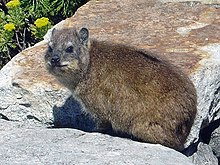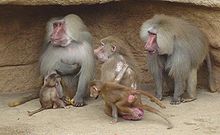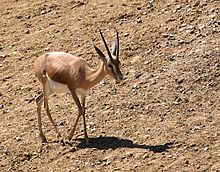List of mammals of Yemen
This is a list of the mammal species recorded in Yemen. There are sixty-nine mammal species in Yemen, of which two are endangered, seven are vulnerable, and three are near threatened. Two of the species listed for Yemen are extinct.[1]
The following tags are used to highlight each species' conservation status as assessed by the International Union for Conservation of Nature:
| EX | Extinct | No reasonable doubt that the last individual has died. |
| EW | Extinct in the wild | Known only to survive in captivity or as a naturalized populations well outside its previous range. |
| CR | Critically endangered | The species is in imminent risk of extinction in the wild. |
| EN | Endangered | The species is facing an extremely high risk of extinction in the wild. |
| VU | Vulnerable | The species is facing a high risk of extinction in the wild. |
| NT | Near threatened | The species does not meet any of the criteria that would categorise it as risking extinction but it is likely to do so in the future. |
| LC | Least concern | There are no current identifiable risks to the species. |
| DD | Data deficient | There is inadequate information to make an assessment of the risks to this species. |
Order: Hyracoidea (hyraxes)
[edit]
The hyraxes are four species of fairly small, thickset, herbivorous mammals in the order Hyracoidea. About the size of a domestic cat, they are well-furred, with rounded bodies and a stumpy tail. They are native to Africa and the Middle East.
- Family: Procaviidae (hyraxes)
- Genus: Procavia
- Cape hyrax, P. capensis LC
- Genus: Procavia

Sirenia is an order of fully aquatic, herbivorous mammals that inhabit rivers, estuaries, coastal marine waters, swamps, and marine wetlands. All four species are endangered.
- Family: Dugongidae

The order Primates contains humans and their closest relatives: lemurs, lorisoids, monkeys, and apes.
- Suborder: Haplorhini
- Infraorder: Simiiformes
- Parvorder: Catarrhini
- Superfamily: Cercopithecoidea
- Family: Cercopithecidae (Old World monkeys)
- Genus: Papio
- Hamadryas baboon, P. hamadryas LC
- Genus: Papio
- Family: Cercopithecidae (Old World monkeys)
- Superfamily: Cercopithecoidea
- Parvorder: Catarrhini
- Infraorder: Simiiformes
Rodents make up the largest order of mammals, with over 40% of mammalian species. They have two incisors in the upper and lower jaw which grow continually and must be kept short by gnawing. Most rodents are small though the capybara can weigh up to 45 kg (99 lb).
- Suborder: Hystricognathi
- Family: Hystricidae (Old World porcupines)
- Genus: Hystrix
- Indian crested porcupine, H. indica LC[3]
- Genus: Hystrix
- Family: Hystricidae (Old World porcupines)
- Suborder: Sciurognathi
- Family: Dipodidae (jerboas)
- Subfamily: Dipodinae
- Genus: Jaculus
- Lesser Egyptian jerboa, J. jaculus LC
- Genus: Jaculus
- Subfamily: Dipodinae
- Family: Muridae (mice, rats, voles, gerbils, hamsters)
- Subfamily: Deomyinae
- Genus: Acomys
- Cairo spiny mouse, Acomys cahirinus LC
- Golden spiny mouse, Acomys russatus
- Genus: Acomys
- Subfamily: Gerbillinae
- Genus: Gerbillus
- Cheesman's gerbil, Gerbillus cheesmani
- Wagner's gerbil, Gerbillus dasyurus
- Black-tufted gerbil, Gerbillus famulus
- Pygmy gerbil, Gerbillus henleyi LC
- Balochistan gerbil, Gerbillus nanus LC
- Large Aden gerbil, Gerbillus poecilops
- Genus: Meriones
- King jird, Meriones rex
- Genus: Gerbillus
- Subfamily: Murinae
- Genus: Arvicanthis
- African grass rat, A. niloticus LC[4]
- Genus: Myomyscus
- Yemeni mouse, Myomys Yemeni
- Genus: Arvicanthis
- Subfamily: Deomyinae
- Family: Dipodidae (jerboas)
Order: Lagomorpha (lagomorphs)
[edit]Lagomorphs comprise rabbits, hares, and pikas. Unlike rodents; they have four incisors on their upper jaws.
Order: Erinaceomorpha (hedgehogs and gymnures)
[edit]The order Erinaceomorpha contains a single family, Erinaceidae, which comprise the hedgehogs and gymnures. The hedgehogs are easily recognised by their spines while gymnures look more like large rats.
- Family: Erinaceidae (hedgehogs)
- Subfamily: Erinaceinae
- Genus: Paraechinus
- Desert hedgehog, P. aethiopicus LC
- Genus: Paraechinus
- Subfamily: Erinaceinae
Order: Soricomorpha (shrews, moles, and solenodons)
[edit]The "shrew-forms" are insectivorous mammals. The shrews and solenodons closely resemble mice while the moles are stout-bodied burrowers.
- Family: Soricidae (shrews)
- Subfamily: Crocidurinae
- Genus: Crocidura
- Arabian shrew, Crocidura arabica
- Genus: Crocidura
- Subfamily: Crocidurinae
Order: Chiroptera (bats)
[edit]The bats' most distinguishing feature is that their forelimbs are developed as wings, making them the only mammals capable of flight. Bat species account for about 20% of all mammals.
- Family: Pteropodidae (flying foxes, Old World fruit bats)
- Subfamily: Pteropodinae
- Genus: Eidolon
- Straw-coloured fruit bat, Eidolon helvum LC
- Genus: Rousettus
- Egyptian fruit bat, Rousettus aegyptiacus LC
- Genus: Eidolon
- Subfamily: Pteropodinae
- Family: Vespertilionidae
- Subfamily: Myotinae
- Genus: Myotis
- Rufous mouse-eared bat, Myotis bocagii LC
- Genus: Myotis
- Subfamily: Vespertilioninae
- Genus: Eptesicus
- Botta's serotine, Eptesicus bottae LC
- Genus: Hypsugo
- Bodenheimer's pipistrelle, Hypsugo bodenheimeri
- Genus: Nycticeinops
- Schlieffen's twilight bat, Nycticeinops schlieffeni LC
- Genus: Pipistrellus
- Kuhl's pipistrelle, Pipistrellus kuhlii LC
- Genus: Rhyneptesicus
- Genus: Eptesicus
- Subfamily: Miniopterinae
- Genus: Miniopterus
- Common bent-wing bat, M. schreibersii VU[7]
- Genus: Miniopterus
- Subfamily: Myotinae
- Family: Rhinopomatidae
- Genus: Rhinopoma
- Egyptian mouse-tailed bat, R. cystops LC[8]
- Lesser mouse-tailed bat, Rhinopoma hardwickei LC
- Greater mouse-tailed bat, Rhinopoma microphyllum LC
- Genus: Rhinopoma
- Family: Molossidae
- Genus: Chaerephon
- Little free-tailed bat, Chaerephon pumila LC
- Genus: Otomops
- Harrison's large-eared giant mastiff bat, Otomops harrisoni VU
- Genus: Tadarida
- Egyptian free-tailed bat, Tadarida aegyptiaca LC
- Genus: Chaerephon
- Family: Emballonuridae
- Genus: Coleura
- African sheath-tailed bat, Coleura afra LC
- Genus: Coleura
- Family: Emballonuridae
- Genus: Taphozous
- Egyptian tomb bat, T. perforatus LC[9]
- Genus: Taphozous
- Family: Nycteridae
- Genus: Nycteris
- Egyptian slit-faced bat, Nycteris thebaica LC
- Genus: Nycteris
- Family: Rhinolophidae
- Subfamily: Rhinolophinae
- Genus: Rhinolophus
- Blasius's horseshoe bat, R. blasii LC[10]
- Geoffroy's horseshoe bat, Rhinolophus clivosus LC
- Genus: Rhinolophus
- Subfamily: Hipposiderinae
- Genus: Asellia
- Trident leaf-nosed bat, Asellia tridens LC
- Genus: Hipposideros
- Sundevall's roundleaf bat, Hipposideros caffer LC
- Genus: Triaenops
- Persian trident bat, Triaenops persicus LC
- Genus: Asellia
- Subfamily: Rhinolophinae



The order Cetacea includes whales, dolphins and porpoises. They are the mammals most fully adapted to aquatic life with a spindle-shaped nearly hairless body, protected by a thick layer of blubber, and forelimbs and tail modified to provide propulsion underwater.
- Suborder: Mysticeti
- Family: Balaenopteridae
- Subfamily: Balaenopterinae
- Genus: Balaenoptera
- Bryde's whale, Balaenoptera edeni DD[11]
- Genus: Balaenoptera
- Subfamily: Megapterinae
- Genus: Megaptera
- Humpback whale, M. novaeangliae LC[12]
- Genus: Megaptera
- Subfamily: Balaenopterinae
- Family: Balaenopteridae
- Suborder: Odontoceti
- Superfamily: Platanistoidea
- Family: Physeteridae (sperm whales)
- Genus: Physeter
- Sperm whale, Physeter macrocephalus VU
- Genus: Physeter
- Family: Kogiidae
- Genus: Kogia
- Pygmy sperm whale, K. breviceps DD[13]
- Dwarf sperm whale, Kogia sima
- Genus: Kogia
- Family: Ziphidae
- Subfamily: Hyperoodontinae
- Genus: Indopacetus
- Longman's beaked whale, I. pacificus DD[14]
- Genus: Mesoplodon
- Blainville's beaked whale, Mesoplodon densirostris DD
- Genus: Indopacetus
- Subfamily: Hyperoodontinae
- Family: Delphinidae (marine dolphins)
- Genus: Steno
- Rough-toothed dolphin, Steno bredanensis DD
- Genus: Sousa
- Chinese white dolphin, Sousa chinensis DD
- Genus: Tursiops
- Common bottlenose dolphin, Tursiops truncatus DD
- Indo-Pacific bottlenose dolphin, Tursiops aduncus DD
- Genus: Stenella
- Spinner dolphin, Stenella longirostris DD
- Pantropical spotted dolphin, Stenella attenuata
- Genus: Delphinus
- Common dolphin, Delphinus capensis
- Genus: Lagenodelphis
- Fraser's dolphin, Lagenodelphis hosei DD
- Genus: Grampus
- Risso's dolphin, Grampus griseus DD
- Genus: Feresa
- Pygmy killer whale, Feresa attenuata DD
- Genus: Pseudorca
- False killer whale, Pseudorca crassidens EN[11]
- Genus: Steno
- Family: Physeteridae (sperm whales)
- Superfamily: Platanistoidea

There are over 260 species of carnivorans, the majority of which feed primarily on meat. They have a characteristic skull shape and dentition.
- Suborder: Feliformia
- Family: Felidae (cats)
- Subfamily: Felinae
- Subfamily: Pantherinae
- Genus: Panthera
- Leopard, P. pardus VU[18]
- Arabian leopard, P. p. nimr CR[18]
- Leopard, P. pardus VU[18]
- Genus: Panthera
- Family: Viverridae
- Subfamily: Viverrinae
- Genus: Genetta
- Common genet, G. genetta LC[19]
- Genus: Genetta
- Subfamily: Viverrinae
- Family: Herpestidae (mongooses)
- Genus: Bdeogale
- Bushy-tailed mongoose, B. crassicauda LC presence uncertain, introduced[20]
- Genus: Ichneumia
- White-tailed mongoose, I. albicauda LC[21]
- Genus: Bdeogale
- Family: Hyaenidae (hyaenas)
- Genus: Hyaena
- Striped hyena, H. hyaena NT[22]
- Genus: Hyaena
- Family: Felidae (cats)
- Suborder: Caniformia
- Family: Canidae (dogs, foxes)
- Genus: Vulpes
- Blanford's fox, V. cana LC[23]
- Rüppell's fox, V. rueppellii LC[24]
- Red fox, V. vulpes LC[25]
- Genus: Canis
- Golden jackal, C. aureus LC[26]
- Gray wolf, C. lupus LC[27]
- Arabian wolf, C. l. arabs
- Genus: Vulpes
- Family: Mustelidae (mustelids)
- Genus: Mellivora
- Honey badger, M. capensis LC[28]
- Genus: Mellivora
- Family: Canidae (dogs, foxes)
Order: Artiodactyla (even-toed ungulates)
[edit]
The even-toed ungulates are ungulates whose weight is borne about equally by the third and fourth toes, rather than mostly or entirely by the third as in perissodactyls. There are about 220 artiodactyl species, including many that are of great economic importance to humans.
- Family: Bovidae (cattle, antelope, sheep, goats)
- Subfamily: Antilopinae
- Genus: Gazella
- Arabian gazelle, G. arabica VU[29]
- Queen of Sheba's gazelle, G. bilkis EX[30]
- Arabian sand gazelle, G. marica VU[31]
- Genus: Gazella
- Subfamily: Caprinae
- Genus: Capra
- Nubian ibex, C. nubiana VU[32]
- Genus: Capra
- Subfamily: Antilopinae
Locally extinct
[edit]The following species are locally extinct in the country:
- Cheetah, Acinonyx jubatus[33]
- Saudi gazelle, Gazella saudiya[34]
- Arabian oryx, Oryx leucoryx[35]
See also
[edit]- List of chordate orders
- Lists of mammals by region
- List of prehistoric mammals
- Mammal classification
- List of mammals described in the 2000s
References
[edit]- ^ This list is derived from the IUCN Red List which lists species of mammals and includes mammals that have recently been classified as extinct (since 1500 AD). The taxonomy and naming of the individual species is based on those used in existing Wikipedia articles as of 21 May 2007 and supplemented by the common names and taxonomy from the IUCN, Smithsonian Institution, or University of Michigan where no Wikipedia article was available.
- ^ Marsh, H. & Sobtzick, S. (2019). "Dugong dugon". IUCN Red List of Threatened Species. 2019: e.T6909A160756767.
- ^ Amori, G.; Hutterer, R.; Kryštufek, B.; Yigit, N.; Mitsainas, G.; Palomo, L. (2021). "Hystrix indica". IUCN Red List of Threatened Species. 2021: e.T10751A197516522.
- ^ Granjon, L. (2016). "Arvicanthis niloticus". IUCN Red List of Threatened Species. 2016: e.T2147A115060432.
- ^ Johnston, C.H.; Robinson, T.J.; Child, M.F. & Relton, C. (2019). "Lepus capensis". IUCN Red List of Threatened Species. 2019: e.T41277A45186750.
- ^ Benda, P.; Srinivasulu, C.; Srinivasulu, B. (2019). "Rhyneptesicus nasutus". IUCN Red List of Threatened Species. 2019: e.T7935A22117147.
- ^ Gazaryan, S.; Bücs, S. & Çoraman, E. (2020). "Miniopterus schreibersii". IUCN Red List of Threatened Species. 2020: e.T81633057A151216401.
- ^ Benda, P. (2017). "Rhinopoma cystops". IUCN Red List of Threatened Species. 2017: e.T82345555A82345569.
- ^ Monadjem, A.; Molur, S.; Hutson, A.M.; Amr, Z.S.S.; Kock, D.; Mickleburgh, S.; Bergmans, W. (2020). "Taphozous perforatus". IUCN Red List of Threatened Species. 2020: e.T21463A166505490.
- ^ Taylor, P. (2016). "Rhinolophus blasii". IUCN Red List of Threatened Species. 2016: e.T19515A21972073.
- ^ a b "Summary review of cetaceans of the Red Sea" (PDF). Retrieved 2024-06-16.
- ^ Cooke, J.G. (2018). "Megaptera novaeangliae". IUCN Red List of Threatened Species. 2018: e.T13006A50362794.
- ^ Taylor, B.L.; Baird, R.; Barlow, J.; Dawson, S.M.; Ford, J.K.B.; Mead, J.G.; Notarbartolo di Sciara, G.; Wade, P. & Pitman, R.L. (2012). "Kogia breviceps". IUCN Red List of Threatened Species. 2012: e.T11047A17692192.
- ^ Anderson, R. C.; Clark, R.; Madsen, P. T.; Johnson, C.; Kiszka, J.; Breysse, O. (2006). "Observations of Longman's Beaked Whale (Indopacetus pacificus) in the Western Indian Ocean". Aquatic Mammals. 32 (2): 223–231. doi:10.1578/AM.32.2.2006.223. S2CID 13691358.
- ^ Avgan, B.; Henschel, P. & Ghoddousi, A. (2016). "Caracal caracal". IUCN Red List of Threatened Species. 2016: e.T3847A102424310.
- ^ Ghoddousi, A.; Belbachir, F.; Durant, S.M.; Herbst, M. & Rosen, T. (2022). "Felis lybica". IUCN Red List of Threatened Species. 2022: e.T131299383A154907281. doi:10.2305/IUCN.UK.2022-1.RLTS.T131299383A154907281.en.
- ^ Sliwa, A.; Ghadirian, T.; Appel, A.; Banfield, L.; Sher Shah, M. & Wacher, T. (2016). "Felis margarita". IUCN Red List of Threatened Species. 2016: e.T8541A50651884.
- ^ a b Stein, A.B.; Athreya, V.; Gerngross, P.; Balme, G.; Henschel, P.; Karanth, U.; Miquelle, D.; Rostro-Garcia, S.; Kamler, J. F.; Laguardia, A.; Khorozyan, I. & Ghoddousi, A. (2019). "Panthera pardus". IUCN Red List of Threatened Species. 2019: e.T15954A160698029.
- ^ Gaubert, P.; Carvalho, F.; Camps, D. & Do Linh San, E. (2015). "Genetta genetta". IUCN Red List of Threatened Species. 2015: e.T41698A45218636.
- ^ White, P.A.; Fischer, C.; Hausser, Y.; Foley, C. & Do Linh San, E. (2016). "Bdeogale crassicauda". IUCN Red List of Threatened Species. 2016: e.T41591A97163568.
- ^ Do Linh San, E. (2015). "Ichneumia albicauda". IUCN Red List of Threatened Species. 2015: e.T41620A45208640.
- ^ AbiSaid, M. & Dloniak, S.M.D. (2015). "Hyaena hyaena". IUCN Red List of Threatened Species. 2015: e.T10274A45195080.
- ^ Hoffmann, M. & Sillero-Zubiri, C. (2015). "Vulpes cana". IUCN Red List of Threatened Species. 2015: e.T23050A48075169.
- ^ Mallon, D.; Murdoch, J.D. & Wacher, T. (2015). "Vulpes rueppelli". IUCN Red List of Threatened Species. 2015: e.T23053A46197483.
- ^ Hoffmann, M. & Sillero-Zubiri, C. (2021) [amended version of 2016 assessment]. "Vulpes vulpes". IUCN Red List of Threatened Species. 2021: e.T23062A193903628.
- ^ Hoffmann, M.; Arnold, J.; Duckworth, J. W.; Jhala, Y.; Kamler, J. F. & Krofel, M. (2018). "Canis aureus". IUCN Red List of Threatened Species. 2018: e.T118264161A46194820.
- ^ Boitani, L.; Phillips, M. & Jhala, Y. (2018). "Canis lupus". IUCN Red List of Threatened Species. 2018: e.T3746A119623865.
- ^ Do Linh San, E.; Begg, C.; Begg, K. & Abramov, A. V. (2016). "Mellivora capensis". IUCN Red List of Threatened Species. 2016: e.T41629A45210107.
- ^ IUCN SSC Antelope Specialist Group (2017). "Gazella arabica". IUCN Red List of Threatened Species. 2017: e.T117582065A88018124.
- ^ IUCN SSC Antelope Specialist Group (2016). "Gazella bilkis". IUCN Red List of Threatened Species. 2016: e.T8987A50188129.
- ^ IUCN SSC Antelope Specialist Group (2017). "Gazella marica". IUCN Red List of Threatened Species. 2017. doi:10.2305/iucn.uk.2017-2.rlts.t8977a50187738.en.
- ^ Ross, S.; Elalqamy, H.; Al Said, T. & Saltz, D. (2020). "Capra nubiana". IUCN Red List of Threatened Species. 2020: e.T3796A22143385.
- ^ Durant, S.; Mitchell, N.; Ipavec, A. & Groom, R. (2015). "Acinonyx jubatus". IUCN Red List of Threatened Species. 2015: e.T219A50649567.
- ^ IUCN SSC Antelope Specialist Group (2016). "Gazella saudiya". IUCN Red List of Threatened Species. 2016: e.T8980A50187890.
- ^ IUCN SSC Antelope Specialist Group (2017). "Oryx leucoryx". IUCN Red List of Threatened Species. 2017: e.T15569A50191626.
External links
[edit]- "Animal Diversity Web". University of Michigan Museum of Zoology. 1995–2006. Retrieved 22 May 2007.
